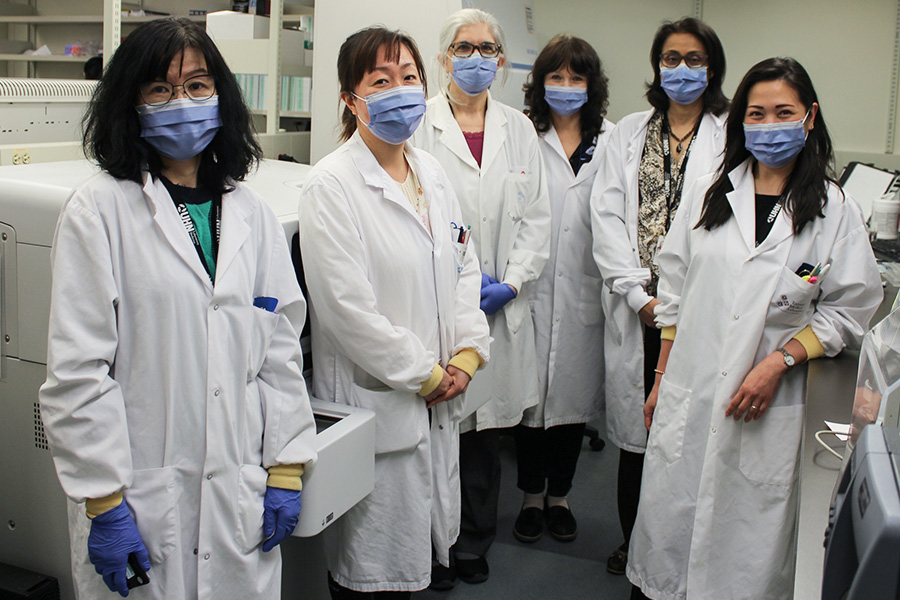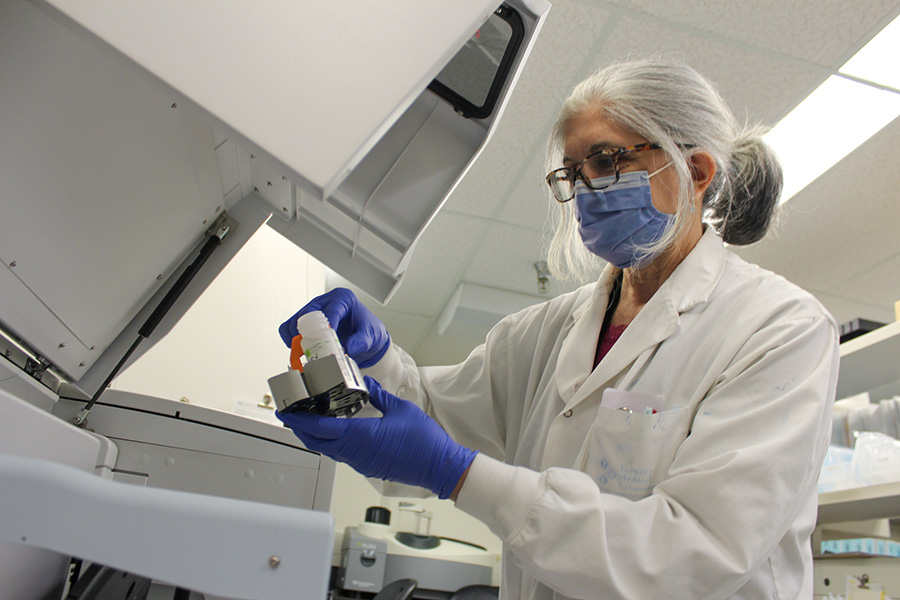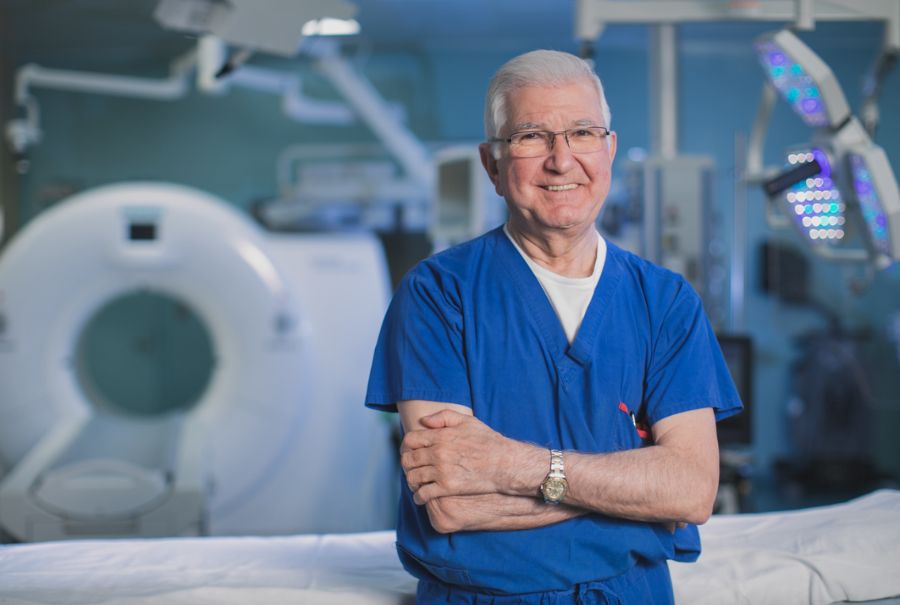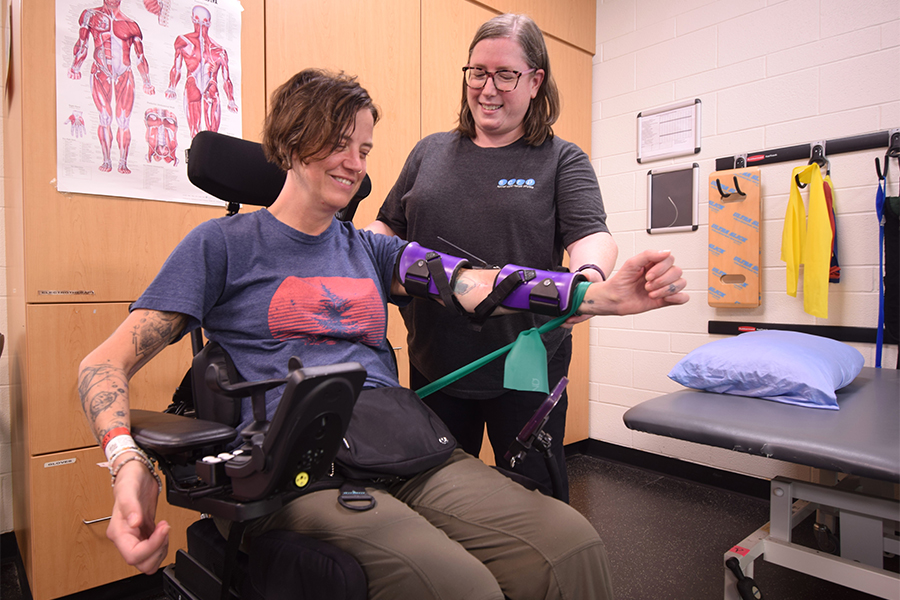Trent Ng, a medical laboratory technologist at UHN, creates images of kidney biopsies that are magnified over 100,000 times with an electron microscope. (Photo: UHN)
When Trent Ng was learning to use an electron microscope (EM) at University Health Network (UHN), he stopped drinking coffee. Steady hands are critical to his work.
Trent cuts tissue samples from kidney biopsies into sections that are 100 nanometres (nm) thin. For reference, one cm is equal to 10 million nm. Once the samples are cut with a diamond blade, he uses a single sterilized eyelash attached to the end of a tiny stick to help scoop the sample up into a copper grid.
“It’s kind of like using a fork to push food onto a spoon,” Trent says. “That was the hardest part of my job to learn.”
Trent is a medical laboratory technologist at UHN’s Laboratory Medicine Program (LMP) who is specially trained to use an EM. He is one of only four staff who work in the area.
Ironically, these tiny samples are loaded into UHN’s largest – 2.1 metres tall, or seven feet – microscope.
Electron microscopes are the most powerful microscopes available and have the highest magnification. There are two main types of electron microscopes: transmission and scanning.
“Our lab uses a transmission electron microscope because we are interested in the interior of samples,” says Trent. “A high-power beam of electron is emitted, which passes through the specimen to generate images.”
An everyday light microscope can magnify objects up to 1,000 times. UHN’s transmission electron microscope can magnify objects over 100,000 times.
“It is a very powerful tool that enables observations not possible with an everyday light microscope,” says Trent. “EM is most useful in helping diagnosis and prognosis of kidney diseases.
“We also perform EM on muscles, skin, nerves, and heart biopsies.”

There are only a handful of electron microscopy labs in Ontario. UHN receives approximately 30 samples per week, supporting care of UHN patients as well others from across the Greater Toronto Area and as far away as Timmins and Thunder Bay.
The EM lab team sends approximately 50 images with every case to Dr. Carmen Avila-Casado and Dr. Rohan John – UHN’s two pathologists who are dedicated solely to examining the cells involved in diseases affecting the kidneys.
“For kidney evaluation, it’s the best practice to always provide EM testing,” says Dr. Avila-Casado. “It is crucial to making the diagnosis.”
National Medical Laboratory Week runs from April 9 to 15. It’s an opportunity to recognize lab professionals for the essential work they do and raise awareness about the profession.
At UHN, more than 700 lab professionals process over 30 million tests every year.
As of April 1, the microbiology lab shared between Sinai Health and UHN had processed more than 3.5 million COVID-19 tests.
“COVID-19 testing may have raised the profile of lab medicine and we are so proud of that incredible work,” says Christine Bruce, Senior Director, LMP. “And now that the lab has the world’s attention, we would be remiss to not showcase so many areas of the lab that provide niche and vital services but don’t receive the proper recognition they deserve.”

The Investigative Coagulation lab at UHN is one of those areas. This small and mighty team of five runs 100,000 specialized blood tests per year, helping to diagnose patients with bleeding or clotting disorders.
Hereditary diseases, trauma, and several underlying conditions can cause clotting (coagulation). This team investigates the causes of hemorrhage and thrombosis (when blood clots block veins or arteries).
“We are always on alert that we may have an urgent case at any time, especially with a bleeding patient on the operating table or in the Emergency Department with a trauma patient,” says Elena Brnjac, charge technologist, LMP. “It’s critical for us to get levels on bleeding patients so that doctors can quickly start the proper treatments.
“For thrombosis patients, we can help diagnose the cause of the clot and limit the risk of uncontrolled clotting, which can be life-threatening.”
During the pandemic, this team is the only lab in Ontario able to test patients reacting to the Johnson & Johnson COVID-19 Vaccine.
“Some patients were developing blood clots as a reaction to the vaccine, and we needed to respond rapidly,” says Elena. “We quickly incorporated the Vaccine-Induced Thrombotic Thrombocytopenia test (VITT) to test antibody levels in patients who were showing symptoms.”
Elena is very proud of her 35-year career in Investigative Coagulation – a career dedicated to her sister who lost her battle with cancer as a toddler.
“My eldest sister passed away from leukemia when she was only 18 months old and when my parents told me that she died of blood cancer I became interested in lab science,” she says.
“As a lab technologist, I may not get to meet patients face-to-face but knowing that I’ve been able to help so many people and their families over the years is truly rewarding.”


